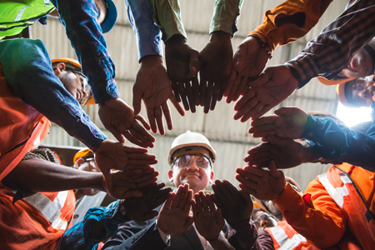The Compounding Benefits Of Driving A Safety-Conscious Culture
By Tanya Moniz-Witten

On the collaborative path toward a safer workplace, employers and employees can discover a whole lot more.
Safety should be a priority for any responsible leader, but organizational mechanisms and procedures focused on ensuring workplace safety are often perceived as “necessary evils” — bothersome impediments to efficiency and progress.
What often gets overlooked are the complementary benefits that come with driving a safety-conscious culture. When a company prioritizes safety, it not only protects its employees physically but also fosters a strong sense of trust and wellbeing, leading to significantly higher employee engagement. People feel valued and empowered. That atmosphere presents enormous opportunity.
In my experience, prioritizing safety opens new channels for collaborative creativity — which is essential to efficiency and progress.
Safety Matters
Earlier this year, I took the helm of San Jose Water (SJW), one of the largest and most technologically sophisticated water systems in the country. While I have decades of utility experience in sizable, regulated, and complex organizations, I was new to SJW. I knew I needed to quickly immerse myself in the culture, get to know the people and processes, and clearly understand how the organization functioned day to day.
Within that context, prioritizing workplace safety was my first leadership initiative — and I considered it a no-brainer. My dad was an electric crew foreman who made safety a way of life. He taught me at a young age the importance of safety and following the rules, and he always said shortcuts had no place in the work environment. No employee should return home injured. Families should expect their loved ones to be in a safe environment. It’s an issue that also directly affects the health of our business — ultimately, safety impacts the hundreds of thousands of customers who rely on SJW for quality drinking water.
Water companies provide an essential and highly regulated service. And SJW has been in business for nearly 160 years. So when it came to safety protocols, there was no need to start from scratch — we could just elevate the systems already in place. SJW already had successful and well-established safety guidelines and procedures, and my colleagues are smart and extremely capable — they know how to do their jobs.
But having good safety guidelines is not the same as being safety conscious. If leaders aren’t talking about safety on a daily basis, they can’t expect staff to believe it’s a real priority. And without intentional direction, it is far too easy for expedient quick fixes to morph into unnecessarily risky standard practices.
Consider what happened to worklife all over the country during the pandemic. People had to figure out how to perform their jobs under extremely different and difficult circumstances, pretty much overnight. Most utilities admirably adapted and improvised to keep systems up and running. In the process, we were all required to tap some serious creativity, and we probably discovered some innovative ways of doing things that have since been integrated into daily operations. But in the aftermath, we may have also let some potentially detrimental workarounds become institutionalized, or just lost “muscle memory” for important safety habits. No good business should be perpetually operating in “emergency” mode.
According to Liberty Mutual’s 2024 Safety Index, workplace injuries cost U.S. businesses over $1 billion a week, “with total injuries costing more than $58 billion every year.” Considering those astounding numbers, it doesn’t take exceptional insight to see that accidents and injuries happen in the workplace. Or that they incur huge costs and sap productivity. Or that actively trying to prevent them is sound policy that directly benefits everyone.
Safety As A Spark
It turns out that my initial call for renewed focus on, and adherence to, safety procedures and best practices was a great kickstart for frank and productive dialog. I’ve been in numerous department meetings, on ride-alongs, in the field, manning a call center, and more as I spend time with our employees. In nearly every interaction, I’ve found that safety is a topic that immediately generates real candor — helping me understand potential pain points and what our teams need to succeed.
This candor has pinpointed issues that are remedied fairly easily for improved efficiency and protocol adherence, such as more comfortable safety vests, work gloves, or safety goggles. It also provides insight into areas where I need to listen and learn, addresses what causes employees to feel overstretched, and identifies how we can better align goals and processes together. And it reveals inspiring safety-conscious ingenuity. For example, one of our teams devised a safer way to collect test samples from a remote creek feeding our mountain surface water supply. Using available materials, they simply secure a jug to the end of a pole: An essential task that once involved rushing water and a steep, slippery trek down a rugged slope is now routinely performed from the relative safety of a nearby platform. Another team at our newest water treatment plant manages 28 valves on each of the seven membrane trains used to filter water. They recently developed a safer way to clear faults from stuck air valves by using an air hose console instead of having to deploy ladders to reach the valves and air lines.
Furthermore, since the console is located on the interior of the membrane train frame and not easily accessible for some operators, the team is also in the process of relocating it outside the frame for even easier — and safer — use.
These conversations have given me a great deal of confidence in my colleagues. I may not have been exposed to the depth of character in our crews or the nature of work in various departments without the subject of safety as a spark. When we set our minds to matters of mutual concern and impact, people are open to offering both genuine criticism and authentic praise — and invested in developing solutions and sharing best practices. That’s the kind of stakeholder participation you get in a safety-conscious organization — enabling collaborative service, training, leadership, and career development opportunities.
In This Together
Our people are the reason we’re able to serve high-quality water, reliably, to customers and local communities every day. Any decent leader understands that keeping your workforce safe creates the kind of organization people are proud and excited to be a part of. I may be new to the company, but I’ve been in utilities long enough to know that the compounding benefits of driving a safety-conscious culture — building trust, instilling confidence, and maintaining a spirit of collaboration — are critical to an effective operation.
References:
About The Author
 Tanya Moniz-Witten is the president of San Jose Water. She is dedicated to delivering reliable, clean, high-quality water to over 1 million customers in the greater San Jose area. In her role, she is responsible for driving strategy and operational excellence and ensuring regulatory compliance for one of the most technologically advanced urban water systems in the country. With over 20 years of utility experience in large, complex organizations, she has a strong commitment to employee safety and engagement. Moniz-Witten attended the University of California, Santa Barbara, where she received a Bachelor of Environmental Studies. She also has a Master of Business Administration from the Wharton School, University of Pennsylvania.
Tanya Moniz-Witten is the president of San Jose Water. She is dedicated to delivering reliable, clean, high-quality water to over 1 million customers in the greater San Jose area. In her role, she is responsible for driving strategy and operational excellence and ensuring regulatory compliance for one of the most technologically advanced urban water systems in the country. With over 20 years of utility experience in large, complex organizations, she has a strong commitment to employee safety and engagement. Moniz-Witten attended the University of California, Santa Barbara, where she received a Bachelor of Environmental Studies. She also has a Master of Business Administration from the Wharton School, University of Pennsylvania.
